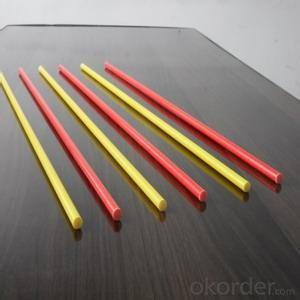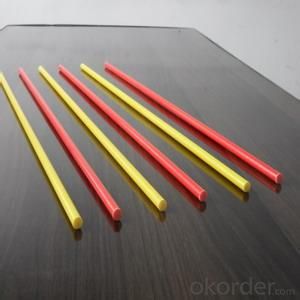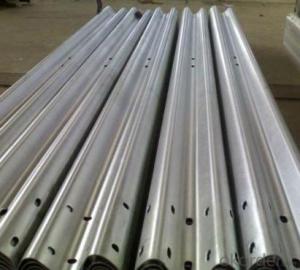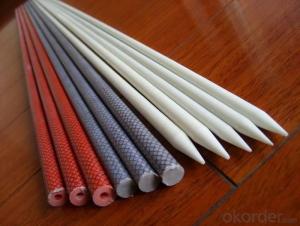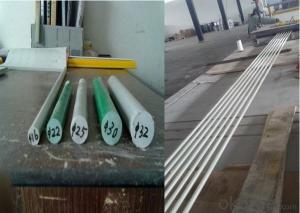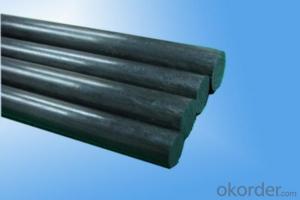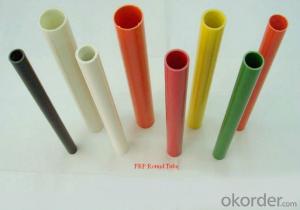FRP Pultrusion Profiles - Excellent Tree Fiberglass Stake
- Loading Port:
- China Main Port
- Payment Terms:
- TT OR LC
- Min Order Qty:
- -
- Supply Capability:
- -
OKorder Service Pledge
OKorder Financial Service
You Might Also Like
Specifications of Excellent Tree Fiberglass Stake:
1.Light Weight
2.High Strength
3.Low Deformation Rate
4.Anti-corrosion and Insulation
Characteristics of Excellent Tree Fiberglass Stake:
1)High Strength
2)Excellent Heat Resistance
3)Low Water Absorption
4)Low Thermal Insulation Coefficient
5)Anti-corrosion
6)Anti-aging
7)Insulation
8)Security
The Pultrusion Process of Excellent Tree Fiberglass Stake: |
Pultrusion is a manufacturing process for producing continuous lengths of reinforced polymer structural shapes with constant cross-sections. Raw materials are a liquid resin mixture (containing resin, fillers and specialized additives) and flexible textile reinforcing fibers. The process involves pulling these raw materials (rather than pushing, as is the case in extrusion) through a heated steel forming die using a continuous pulling device. |
T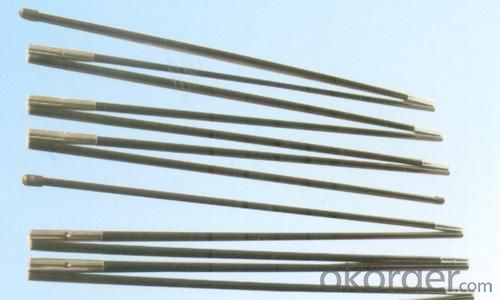
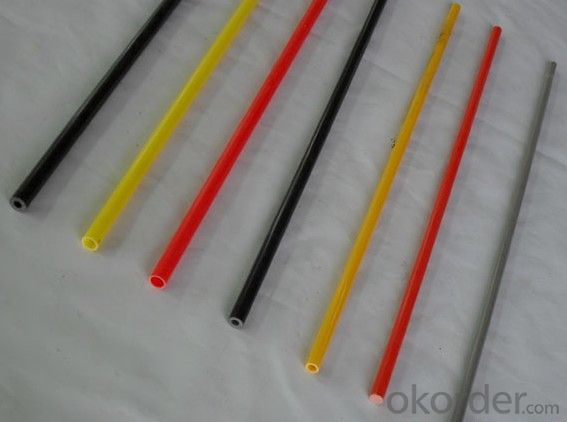
- Q: Can FRP pultrusion profiles be used in agricultural structures?
- Yes, FRP pultrusion profiles can be used in agricultural structures. FRP (Fiber Reinforced Polymer) pultrusion profiles offer several advantages that make them suitable for agricultural applications. Firstly, FRP profiles are corrosion-resistant, which is crucial in the agricultural industry where structures are exposed to harsh environments and chemicals, such as fertilizers and pesticides. Unlike traditional materials like steel or wood, FRP does not rust or decay, ensuring long-lasting performance in agricultural structures. Secondly, FRP profiles are lightweight yet durable, making them easy to handle and install in agricultural applications. They have high strength-to-weight ratios, allowing for efficient construction and reducing the need for heavy machinery during installation. Additionally, FRP profiles offer excellent mechanical properties such as high stiffness and impact resistance, which are beneficial for agricultural structures that may face heavy loads, vibrations, or impact from machinery. Furthermore, FRP pultrusion profiles can be designed to be UV resistant, preventing degradation from prolonged exposure to sunlight. This makes them suitable for outdoor agricultural structures that are constantly exposed to the elements. Lastly, FRP profiles are non-conductive, which is advantageous in agricultural environments where electrical safety is critical. This property eliminates the risk of electrical hazards associated with conductive materials like steel. Overall, FRP pultrusion profiles provide a reliable and efficient solution for various agricultural structures, such as greenhouse frames, livestock enclosures, irrigation systems, and storage facilities. Their corrosion resistance, lightweight nature, high strength, UV resistance, and non-conductivity make them a suitable choice for agricultural applications.
- Q: Can FRP pultrusion profiles be used in the construction of safety barriers?
- Yes, FRP pultrusion profiles can be used in the construction of safety barriers. FRP (Fiber Reinforced Polymer) pultrusion profiles offer high strength-to-weight ratio, corrosion resistance, and durability, making them suitable for safety barrier applications. They can withstand harsh environmental conditions and provide excellent impact resistance, making them an ideal choice for ensuring safety in various industries such as construction, transportation, and infrastructure.
- Q: Are FRP pultrusion profiles resistant to chemical spills or leaks?
- Yes, FRP (Fiber Reinforced Polymer) pultrusion profiles are highly resistant to chemical spills or leaks. The combination of the fiberglass reinforcement and the polymer matrix used in FRP pultrusion provides excellent resistance to a wide range of chemicals, acids, and corrosive substances. This makes FRP pultrusion profiles a suitable choice for applications where chemical resistance is crucial, such as in chemical processing plants, wastewater treatment facilities, and storage tanks.
- Q: The difference between polyurethane pultruded profiles and glass reinforced plastic profiles
- Pultrusion production of polyurethane pultruded profiles can be used in the new type of polyurethane material, the product can completely replace the FRP pultruded profiles, including polyurethane doors and windows profiles, tray, line guide groove, groove, polyurethane polyurethane tube and other molding parts.
- Q: Can FRP pultrusion profiles be used in railway applications?
- Yes, FRP (Fiber Reinforced Polymer) pultrusion profiles can be used in railway applications. FRP pultrusion profiles are known for their high strength-to-weight ratio, corrosion resistance, and durability, making them ideal for various industries, including railways. In railway applications, FRP pultrusion profiles can be used for a wide range of components such as railway sleepers, bridges, platforms, cable management systems, and even structural support for railway tracks. These profiles offer excellent mechanical properties, including high stiffness and tensile strength, which are crucial for ensuring the safety and integrity of railway infrastructure. Furthermore, FRP pultrusion profiles have low thermal conductivity, making them resistant to extreme temperature variations. This is advantageous in railway applications where exposure to both hot and cold temperatures is common. Another significant advantage of using FRP pultrusion profiles in railway applications is their resistance to corrosion. Unlike traditional materials like steel, FRP does not rust or corrode in the presence of moisture or chemicals. This corrosion resistance minimizes the need for regular maintenance and extends the lifespan of railway components, reducing costs in the long run. Additionally, FRP pultrusion profiles can be easily customized to meet specific design requirements. They can be manufactured in various shapes, sizes, and colors, enabling engineers to create tailored solutions for different railway applications. Overall, the use of FRP pultrusion profiles in railway applications provides numerous benefits, including lightweight design, high strength, corrosion resistance, and customization options. These qualities make FRP an attractive alternative to traditional materials and contribute to the overall safety, efficiency, and longevity of railway infrastructure.
- Q: Can FRP pultrusion profiles be used in automotive applications?
- FRP pultrusion profiles can indeed be utilized in automotive applications, presenting a myriad of advantages that render them appropriate for such use. Firstly, these profiles possess the dual attributes of being lightweight and strong, which holds immense significance within the automotive industry. As weight reduction stands as a top priority for enhancing fuel efficiency and performance, the commendable strength-to-weight ratio of FRP profiles enables the creation of lighter vehicles that consume less fuel. Secondly, FRP pultrusion profiles exhibit exceptional corrosion resistance, a vital characteristic for automotive applications routinely encountering exposure to various chemicals, moisture, and harsh environments. This corrosion resistance ensures the long-term dependability and durability of the profiles, ultimately reducing maintenance expenses and prolonging the lifespan of automotive components. Moreover, FRP pultrusion profiles offer remarkable design flexibility, thereby facilitating the formation of intricate shapes and geometries that can be customized to meet specific automotive requirements. This flexibility allows for the seamless integration of FRP profiles into numerous automotive components, including body panels, structural supports, interior trims, and suspension parts. Additionally, FRP pultrusion profiles demonstrate high fatigue resistance, a crucial aspect for automotive applications that involve repetitive loading and vibrations. The fatigue resistance of FRP profiles guarantees their enduring performance and aids in averting failures and breakdowns. Lastly, FRP pultrusion profiles are non-conductive, an advantageous attribute in automotive applications necessitating electrical isolation. This property obviates the necessity for supplementary insulation and mitigates the risk of electrical failures and short circuits. All in all, the amalgamation of lightweightness, robustness, corrosion resistance, design flexibility, fatigue resistance, and electrical non-conductivity renders FRP pultrusion profiles suitable for diverse automotive applications, thereby contributing to enhanced performance, fuel efficiency, durability, and safety within the automotive industry.
- Q: Can FRP pultrusion profiles be used in the construction of elevated walkways?
- Yes, FRP pultrusion profiles can be used in the construction of elevated walkways. FRP (Fiber Reinforced Polymer) pultrusion profiles offer several advantages such as high strength-to-weight ratio, corrosion resistance, and durability, making them suitable for various construction applications including elevated walkways. They are lightweight, yet strong enough to support pedestrian traffic and withstand environmental conditions. Additionally, FRP pultrusion profiles can be easily customized to meet specific design requirements, making them a popular choice in the construction industry.
- Q: Are FRP pultrusion profiles resistant to electromagnetic interference?
- Yes, FRP pultrusion profiles are generally resistant to electromagnetic interference (EMI). The use of fiberglass reinforced plastic (FRP) in pultrusion profiles provides excellent electrical insulation properties, which help to minimize the effects of electromagnetic interference. Unlike metals, which are conductive and can easily transmit electrical signals, FRP materials have high dielectric strength and low electrical conductivity. This makes FRP pultrusion profiles less susceptible to EMI and allows them to act as barriers to electromagnetic waves. Additionally, FRP materials can be further enhanced with additional layers or coatings to increase their EMI shielding effectiveness if required. Overall, FRP pultrusion profiles are a reliable choice for applications where resistance to electromagnetic interference is important.
- Q: Are FRP pultrusion profiles resistant to oil or fuel spills?
- FRP pultrusion profiles exhibit a general resistance to oil or fuel spills, which is well-known in the industry. This is due to their exceptional chemical resistance, particularly against oils and fuels, which is attributed to the combination of the polymer resin and reinforcing fibers. This unique blend creates a robust and enduring material capable of withstanding exposure to various substances. The impermeable nature of FRP pultrusion profiles is another significant advantage, making them impervious to oil and fuel. Consequently, even in the event of a spill, these profiles will not absorb the substances, thus preventing any potential harm or deterioration. Furthermore, FRP possesses corrosion resistance and does not react with oils or fuels, ensuring its longevity and performance. These remarkable qualities make FRP pultrusion profiles highly sought after in industries where oil or fuel spills are a concern, such as oil refineries, chemical plants, and offshore platforms. They provide a dependable solution for applications requiring resistance to chemical exposure, offering a cost-effective and low-maintenance alternative to conventional materials.
- Q: What are the different surface finishes available for FRP pultrusion profiles?
- Some of the different surface finishes available for FRP pultrusion profiles include smooth, textured, non-skid, and glossy finishes. These finishes can enhance the aesthetics, improve grip, and provide protection against UV radiation and corrosion.
Send your message to us
FRP Pultrusion Profiles - Excellent Tree Fiberglass Stake
- Loading Port:
- China Main Port
- Payment Terms:
- TT OR LC
- Min Order Qty:
- -
- Supply Capability:
- -
OKorder Service Pledge
OKorder Financial Service
Similar products
Hot products
Hot Searches
Related keywords
